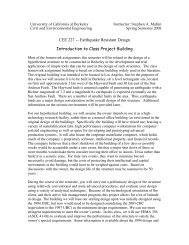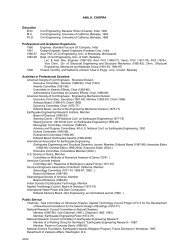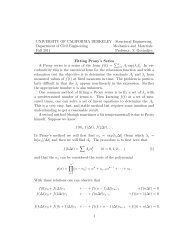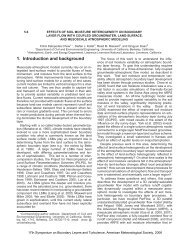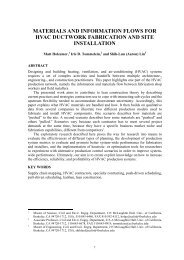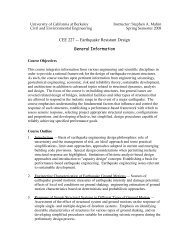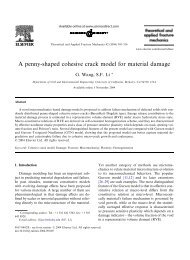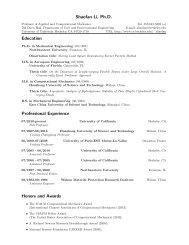Meshfree and particle methods and their applications - TAM ...
Meshfree and particle methods and their applications - TAM ...
Meshfree and particle methods and their applications - TAM ...
Create successful ePaper yourself
Turn your PDF publications into a flip-book with our unique Google optimized e-Paper software.
22 Li <strong>and</strong> Liu: <strong>Meshfree</strong> <strong>and</strong> <strong>particle</strong> <strong>methods</strong> <strong>and</strong> <strong>applications</strong> Appl Mech Rev vol 55, no 1, January 2002<br />
namics, one does not calculate electron distribution anymore,<br />
the forces acting on each atom are determined by a potential<br />
function, ie,<br />
d 2<br />
m i<br />
dt 2 R i V (105)<br />
which is determined from either empirical knowledge, or<br />
from ab initio computations.<br />
For example, in a polar molecule system of ionic crystal,<br />
or polar molecule system, the potential is mainly due to electrostatic<br />
interaction, thus<br />
q<br />
VR ij <br />
n R j <br />
(106)<br />
j R i R j <br />
where R ij R i R j <strong>and</strong> q n is the charge distribution.<br />
The most well-known potential, originally proposed for<br />
inert-gas elements, is the Lennard-Jones LJ potential<br />
310,311, which is a typical Van der Waals potential. For a<br />
pair of atoms i <strong>and</strong> j located at R i <strong>and</strong> R j , the potential<br />
energy is<br />
R 0<br />
(107)<br />
V ij 4 0 R 12<br />
0<br />
R ij<br />
6<br />
R ij<br />
where 0 <strong>and</strong> R 0 are the minimum energy <strong>and</strong> collision diameter<br />
between the two atoms. respectively. The corresponding<br />
force between the two atoms is given by<br />
F ij VR ij<br />
24 0<br />
R ij R<br />
2 R 13<br />
R ij<br />
R R ij<br />
7<br />
. (108)<br />
The Lennard-Jones LJ potential has been used by Falk <strong>and</strong><br />
Langer 101,312,313 to simulate fracture as well as shear<br />
b<strong>and</strong> in noncrystalline or amorphous solids.<br />
In general, for simulation of anisotropic crystalline solid,<br />
the LJ potential, or pair potential, is not accurate anymore,<br />
<strong>and</strong> more complex potentials are needed, because the LJ potential<br />
is unable to represent specific interaction patterns due<br />
to specific lattice structures. To remedy this inadequacy, the<br />
embedded-atom potential method EAM has been used in<br />
simulations. The embedded-atom potential Daw <strong>and</strong> Baskes<br />
314 consists of two sources: 1 the embedding energy for<br />
each atom to be introduced to the system, <strong>and</strong> 2 the short<br />
range core-to-core repulsion between nucleus pairs. Thus, its<br />
potential has the form,<br />
V<br />
i<br />
F i h,i 1 2 i<br />
<br />
j<br />
ij R ij (109)<br />
where (R ij ) represents the pair potential, <strong>and</strong> F i ( h,i ) represents<br />
the embedding energy of atom i, <strong>and</strong> h,i is the density<br />
of the host at the position of R i but without atom i. For<br />
example, in simulation of semiconductors, the fourfold coordinated<br />
Stillinger-Weber potential is adopted 315,316,<br />
which consists of a two-body part of LJ type<br />
f 2 R ij ABR 4 ij 1expR ij a 1 (110)<br />
<strong>and</strong> a three-body part<br />
f 3 R ij ,R ik , ijk expR ij a 1 R ik a 1 <br />
cos jik 1/3 2 . (111)<br />
Between ab initio <strong>methods</strong> <strong>and</strong> classical molecular dynamics,<br />
there are other semi-empirical <strong>methods</strong>, such as the<br />
Tight-Binding Method 317–319. The Tight-Binding<br />
method is a quantum mechanics method, because the forces<br />
acting on each atom are based on quantum mechanics, but it<br />
uses empirical parameters in the construction of the Hamiltonian.<br />
Those parameters can be obtained from either experiments<br />
or ab initio simulations.<br />
4.5 Applications<br />
4.5.1 Mechanics of nanotubes filled with fullerenes<br />
The recent resurgence of molecular dynamics, both quantum<br />
<strong>and</strong> classical, is largely due to the emergence of nanotechnology.<br />
Materials at the nanoscale have demonstrated<br />
impressive physical <strong>and</strong> chemical properties, thus suggesting<br />
a wide range of areas for <strong>applications</strong>. For instance, carbon<br />
nanotubes are remarkably strong, <strong>and</strong> have better electrical<br />
conductance, as well as heat conducivity than copper at room<br />
temperature. Moreover, nanotubes are such light weight <strong>and</strong><br />
high-strength TPa materials that they eventually will play<br />
an important role in reinforced fiber composites, <strong>and</strong> as both<br />
devices <strong>and</strong> nanowires. In particular, nanotubes having<br />
fullerenes inside could have different physical properties<br />
compared to empty nanotubes. Such structures also hold<br />
promise for use in potential functional devices at nanometer<br />
scale: nano-pistons, nano-bearings, nano-writing devices,<br />
<strong>and</strong> nano-capsule storage system.<br />
Modeling of nanotubes filled with fullerenes has two aspects:<br />
1 the bonded interaction between fullerenes <strong>and</strong><br />
nanotubes; 2 the bonded interactions among the carbon atoms<br />
of the nanotubes. Recently, Qian et al 320 used combined<br />
molecular dynamics <strong>and</strong> meshfree Galerkin approach<br />
to simulate interaction between fullerenes <strong>and</strong> a nanotube. In<br />
the non-bonded interaction, the nanotube is modeled as a<br />
continuum governed by the Cauchy-Born rule eg Tadmor<br />
et al 321 <strong>and</strong> Milstein 322. For the bonded interaction, a<br />
modified potential is used to simulate interactions among<br />
carbon atoms. Specifically, Tersoff-Brenner model Tersoff<br />
323, Brenner 1990 324 is used in simulation,<br />
ij R ij R R ij B¯ij A R ij (112)<br />
where R <strong>and</strong> A represent the repulsive <strong>and</strong> attractive potential<br />
respectively,<br />
(e)<br />
D ij<br />
R R ij f R ij <br />
S ij 1 exp2S ij ij R ij R ij<br />
(e) <br />
(113)<br />
A R ij f R ij D (e) ij S ij<br />
S ij 1 exp2/S ij ij R ij R (e) ij .<br />
(114)<br />
For carbon-carbon bonding, D (e) ij 6.0 eV, S ij 1.22, ij<br />
2.1 A 1 , R e ij 1.39 A, <strong>and</strong>



